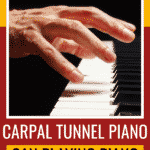Does playing the piano cause carpal tunnel syndrome? Yes, it can. The repetitive motions found in piano playing is a risk factor for carpal tunnel, especially if you are using improper technique.
However, a focus on correct piano technique and body positioning, as well as some other easy steps, can go a long way to prevent carpal tunnel from playing piano.
Playing the piano is quite a workout for your hands and wrist, especially when you practice piano for long periods. Because of this, pianists run the risk of developing carpal tunnel syndrome, which is caused by median nerve compression. The median nerve supplies the front forearm, and when compressed it can lead to thumb and wrist pain, hand pain, and other symptoms that can be irritating or even debilitating.
Carpal tunnel syndrome is a common repetitive stress injury among people who use their wrists and hands frequently. For example, people who sit at a desk typing on the computer for a living are prone to developing carpal tunnel.
Playing the piano uses the same muscles and motions, so pianists and people who play the piano regularly are also prone to developing carpal tunnel.
You need to think about proper piano technique to prevent piano injuries, including carpal tunnel syndrome.
In this post, we go over proper techniques that help with preventing carpal tunnel piano syndrome when playing piano. Your piano teacher should also be a great resource for helping you avoid incorrect technique that can lead to carpal tunnel.
Post Contents
Keep Your Wrists Properly Aligned
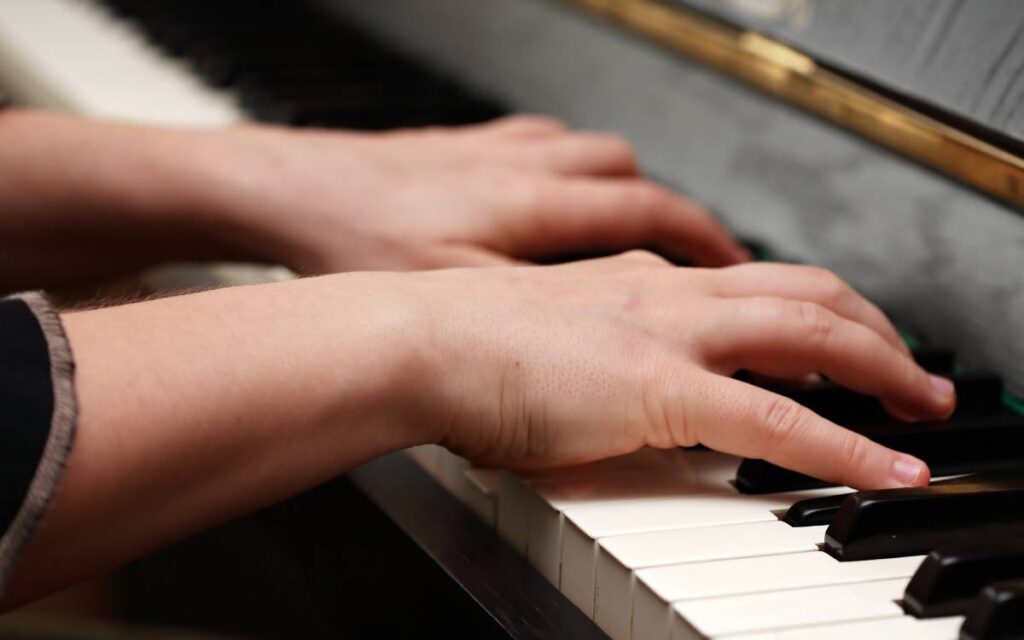
First, you need to be cognizant of your hand and wrist position when you are playing piano. Try to keep your wrists straight when you are playing. Even though this is something that was probably covered during your first piano lesson, it is easy to slip into bad habits when practicing.
When you sit down at the piano, the first thing you should think about is your hand position. Awkward hand positions lead to bad technique. Think about this when you are warming up with your scales.
If you keep your wrists in a neutral position that is level with your hand, you will keep your carpal tunnel open, preventing inflammation from developing in this part of your arm during piano playing.
Align Your Hips, Shoulders, and Head

To help prevent carpal tunnel, you need to remove as much stress as possible from your wrists during piano playing sessions. One way to do this is to align your entire body, developing good habits.
For example, you should align your hips, shoulders, and head in a neutral position when you sit. As much as possible, think about drawing a straight line from your hips to the top of your head.
If you do that, you will maintain proper posture that aligns the natural curve of your body. This will make it easier for you to keep your wrists level as well.
If you do not keep the rest of your body aligned, you will start to slouch. You have probably been told that sitting up straight is important for playing the piano well.
If you start to slouch, your arms and elbows will slouch as well. This will move your wrists out of the proper position, increasing your chances of developing carpal tunnel and the wrist pain that goes along with it.
Play With Your Arm, Not Your Wrists
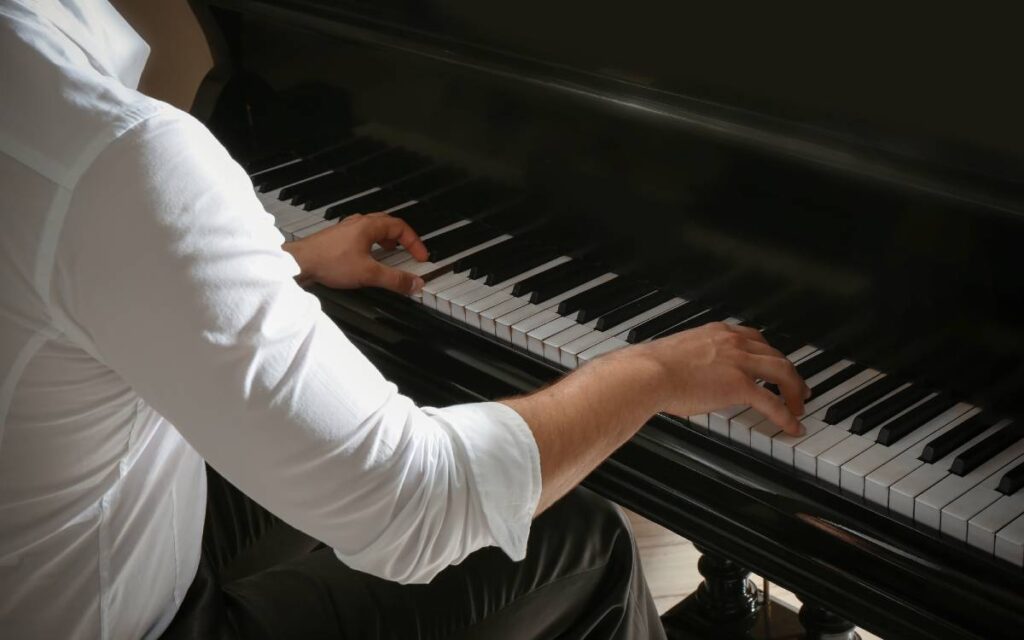
It’s instinctive to play the piano with your wrists, since the wrist supports the hands. Even though this might be the easiest way to strike the keys, it is also the fastest way to develop carpal tunnel. Keep in mind that you need to remove stress from your wrists. One of the ways to do that is to play with your arms instead of your wrists.
As you play the piano, think about using the weight of your arm to strike the keys. Try to move your arms up and down as you play the notes. Your fingers will do the work naturally, but you need to think about shifting the responsibility of piano playing from your wrist.
If you spread the work out over the entirety of your arm instead of focusing it on your wrist, you can reduce your chances of developing carpal tunnel.
Think About the Height of the Bench

You should also consider the height of the bench. Particularly if other pianists have access to a piano, the bench may change in height from time to time.
If the bench is not comfortable for you, take a few minutes to adjust it. A lot of piano benches have a knob you can turn to change the height with a flick of the wrist.
If you adjust the bench height before piano playing sessions, you can reduce your chances of developing carpal tunnel syndrome and all the pain that comes with it.
If your bench is not adjustable, you may want to consider adding a few blankets or towels underneath the bench to make it higher for you.
If the bench is too high, then you may want to get a different bench entirely. If the bench is too high or too low, you will place added stress on your arms and wrists, making it easier for you to develop carpal tunnel syndrome from piano playing.
Stretch Your Wrists

It is also important for you to stretch your wrists regularly. That way, you can keep your carpal tunnel loose, reduce inflammation, break up lactic acid, and protect your valuable fingers.
There are plenty of stretches you can do that can help with improving your motor skills and preventing carpal tunnel syndrome.
Before and after you play the piano, you should do some warmup movements and stretching exercises for pianists. Always start by shaking out your fingers. This will get your tendons, ligaments, and muscles ready to make some music. This can also help you remove lactic acid after you are done practicing.
Then, you may want to perform some other stretches. For example, you should start by pulling your fingers back toward you. Hold this stretch for 10 seconds, and then release.
Then, bend your fingers in the opposite direction. Again, hold this stretch for 10 seconds, and then release.
All you have to do is take a few minutes to stretch your wrists from time to time. This can go a long way toward reducing compression of the median nerve and helping you avoid carpal tunnel.
Ice Your Hands and Wrists
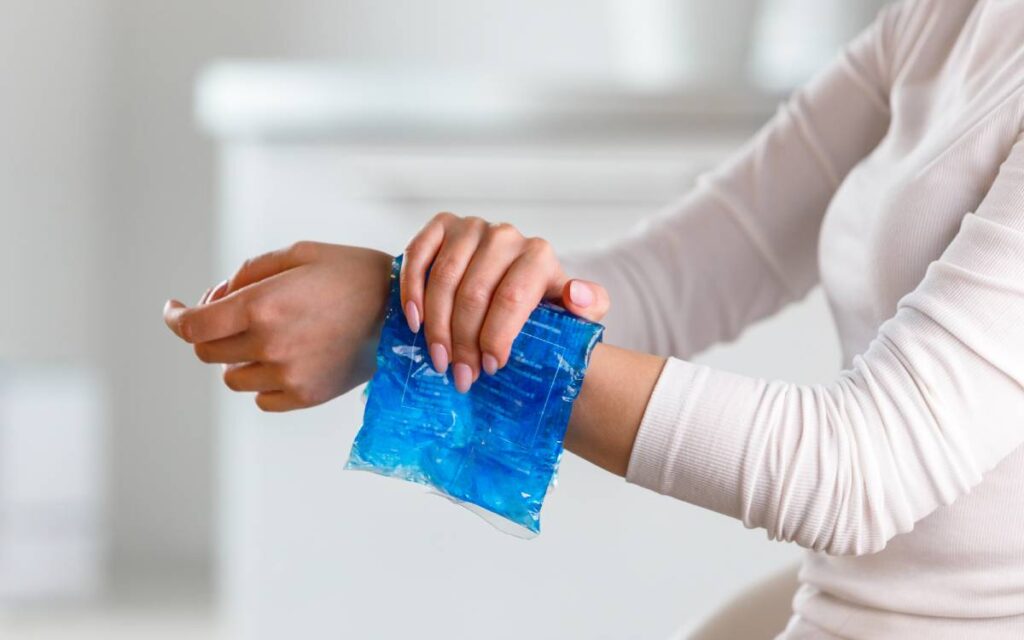
Finally, if you are experiencing pain or numbness you should consider icing your hand and wrist. Even though you do not have to do this every day, it is something that you should do regularly. If you play the piano for several hours a day, you may want to ice your hands and wrists several times a week.
Ice is important because it reduces inflammation. Inflammation can lead to swelling of the carpal tunnel and compression of the median nerve, which can cause carpal tunnel syndrome.
If you apply ice after you practice piano, you quench this inflammation, protecting your wrist from harm.
Make sure you do not leave the ice in place too long – 15-20 minutes at a time is sufficient. It is also a good idea to wrap the ice pack in a towel. That way, you don’t have to worry about ice burning the surface of your skin.
What Are the Symptoms of Carpal Tunnel Syndrome?

Even though you need to follow the tips above to prevent carpal tunnel syndrome, it is one of the most common piano injuries, so you also need to understand how to stop this condition if it develops.
Similar to other medical conditions, the symptoms of carpal tunnel can vary markedly depending on the severity of the condition.
Carpal Tunnel Piano Symptoms

There are several common carpal tunnel piano symptoms you should watch for. These include:
- You may have numb hands and feel tingling in your fingers that progresses to wrist pain. This is typically one of the first symptoms of carpal tunnel.
- You may notice electrical shocks that travel from your forearm down your wrist and into your hand.
- The symptoms will probably get worse if you type on the computer or send a text message on your phone.
- You may have a difficult time playing the piano due to pain and tingling in your hand and wrist.
- You may even notice that your range of motion is markedly reduced.
- You might have a difficult time grasping a cup, eating your food, or driving a car.
Anything that causes you to flex your hand, wrists, and fingers is probably going to make the symptoms of carpal tunnel worse.
If you are experiencing these symptoms, you need to see a doctor as quickly as possible. Even though there is a good chance they are caused by playing a piano, this is not necessarily guaranteed. For example, it could be a sign of nerve damage due to diabetes.
Early intervention is important. Therefore, you should always see a doctor to figure out where the symptoms are coming from. Once you have an accurate diagnosis, the doctor can discuss your treatment options with you.
If you are developing carpal tunnel syndrome, physical therapy might be able to treat the symptoms. If you have a serious injury and the condition does not improve, surgery might be required.
Frequently Asked Questions About Developing Carpal Tunnel Syndrome from Piano Playing
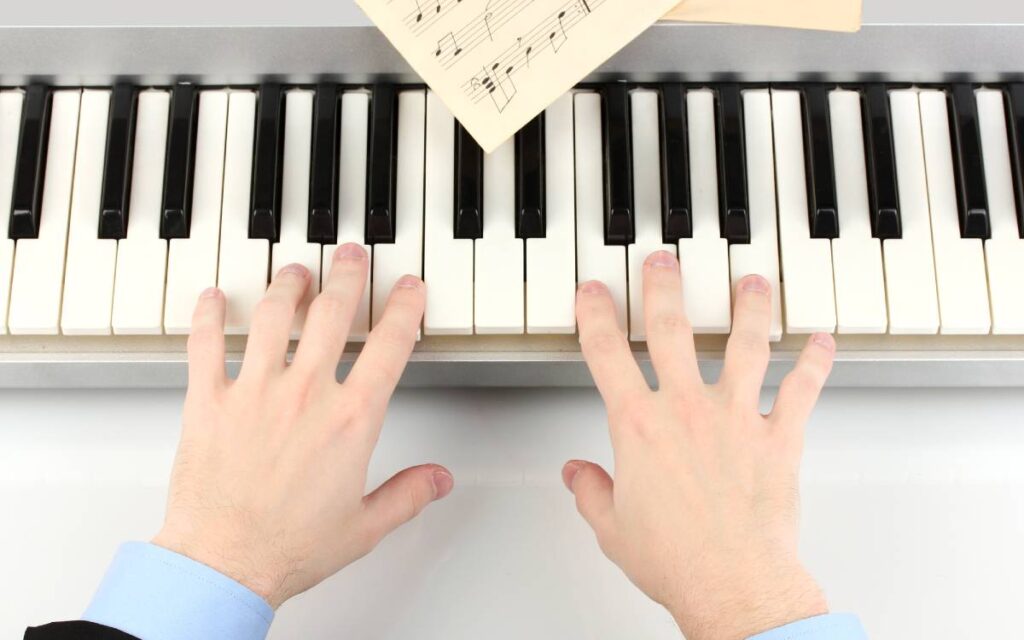
There are a few common questions people have about carpal tunnel syndrome and playing the piano. These include:
What do I need to do if I am feeling pain in my wrists when I am playing the piano?
Even though you might be tempted to push through the pain, this is probably not the best idea. You could make the condition worse. You need to take a break if you are experiencing hand pain like your wrists and fingers hurting.
What is the best way for me to get my wrists and fingers loose before I play the piano?
Playing a few quick scales and arpeggios before practice sessions is important for getting your fingers ready to go. Make sure to really focus on proper technique while warming up. You should also take a few minutes to stretch your hands and wrists before you start playing, which will help prevent injury.
Should I sleep with an ice pack or heating pack on my wrists?
No, you should not do this. This is a good way to burn your hands, fingers, and wrists. You should only use ice and heat in short intervals, not for long periods over 15-20 minutes.
How is carpal tunnel syndrome treated?
If you have a mild case and seek treatment early, it’s entirely possible for pianists to avoid surgery when treating carpal tunnel.
Treatment options include proper rest, wearing wrist supports like a splint or wrist brace on the injured wrist at night, and performing nerve gliding exercises that help with proper movement of the median nerve. Taking non-steroidal anti-inflammatory drugs (NSAIDs) such as ibuprofen to dull your pain, , and finally steroid injections to reduce inflammation are also forms of non-surgical treatment.
If the pain does not subside from these methods, other forms of treatment involve outpatient surgery. Pianists who undergo surgery to correct their injured wrist may experience full recovery, but it can take a year or more.
What are the most common piano injuries?

Because playing piano music involves repetitive motions, pianists may be at risk for a range of injuries affecting the hand, thumb, wrist, upper arm, and even the back and shoulders. These include:
Tendonitis (swelling of the connective tissue in the hand, thumb, wrist, or elbow)
Carpal Tunnel Syndrome (pain and numbness caused by pressure on the median nerve)
Tennis elbow (strain on the tendons in the elbow, causing pain and numbness)
Thoracic outlet syndrome (compression of the blood vessels near your collarbone)
Practicing proper piano technique, warming up with dexterity exercises before practice sessions, and regularly engaging in stretching and other movements can help prevent these repetitive stress injuries.
If you dedicate your practice toward developing good technique as posture, you’ll go a long way to keeping yourself healthy and pain free, so you can keep making music!

